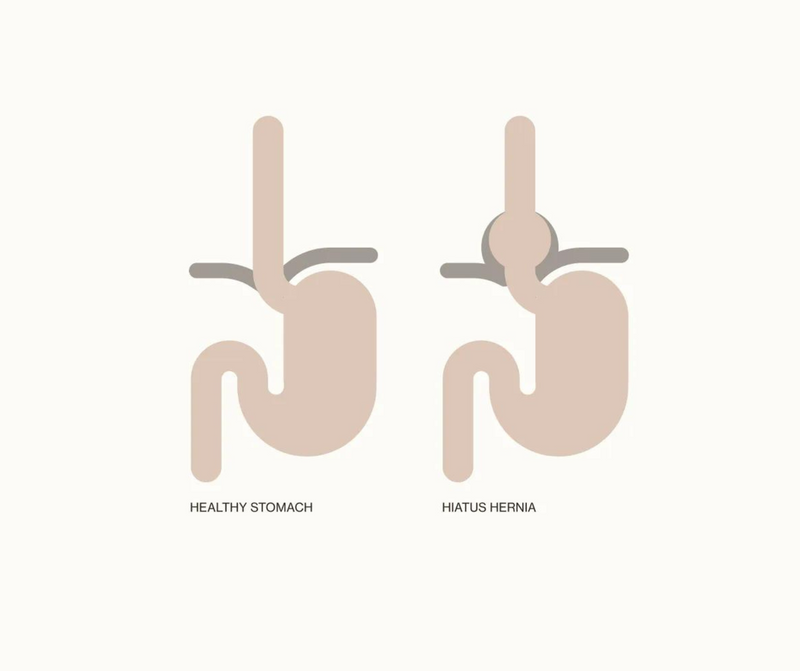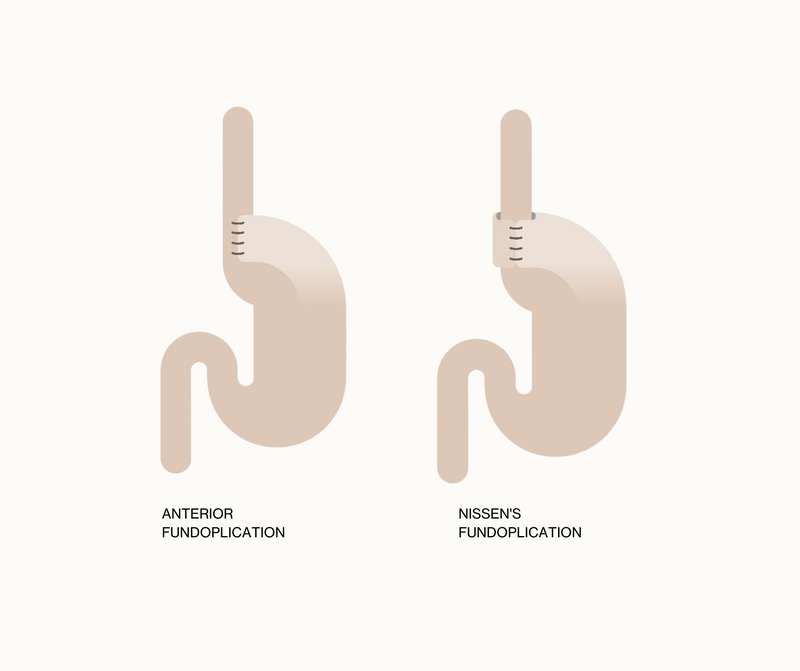What is a hiatus hernia?
Your diaphragm has a small opening for your oesophagus, called your hiatus.
A hiatus hernia occurs when your stomach bulges through your diaphragm (the muscle separating your chest and abdomen).
If your hiatus hernia is small, it usually doesn’t cause any problems. A larger hiatus hernia can cause acid reflux, as well as heartburn and even a twisting of your stomach (volvulus).
What are the problems caused by hiatus hernia?
- Reflux, with burning or an acid taste in your mouth.
- Iron deficiency anaemia from ulcers (Cameron’s ulcers), caused by your stomach rubbing on your diaphragm (because of the hernia)
- Shortness of breath or difficulty with breathing and poor exercise tolerance (Stomach may press on the heart and limit the ability to pump blood and oxygen around the body)
- Chest pain
- Difficulty swallowing,
- Cough or worsening of asthma symptoms (Irritation or aspiration of fluid from your stomach up to your mouth and even into your lungs)
- Rarely, the stomach can twist requiring emergency surgery (volvulus)
What is hiatus hernia surgery?
Hiatus hernia surgery involves Dr Balalis stitching your diaphragm closed, after reducing the hernia (making sure your stomach is back in your abdomen).
If the tissue is weak, Dr Balalis will sometimes place an absorbable mesh or carefully wraps and stitches the top of the stomach (fundus) to create a valve-like effect.
What about acid reflux?
Acid reflux is the result of stomach acid passing up into your oesophagus. When this occurs frequently, it can cause a burning sensation in your chest (heartburn) or acid in the back of your mouth. Over time and with repetition, this acid can also cause the lining of your oesophagus to become inflamed (oesophagitis) or scar. Acid reflux is often a significant side effect of a hiatus hernia.
Who should consider acid reflux surgery?
Dr Balalis performs acid reflux surgery for patients who struggle to manage their symptoms on acid-suppression medication (PPI), patients who do not want to take tablets for the rest of their life, or those who have had ulcers or oesophagitis (inflammation of their oesophagus).
Acid reflux surgery involves Dr Balalis stitching your diaphragm tight to reduce the size of the area, and then re-creating the lower oesophagus valve by wrapping the fundus of your stomach around the lower oesophagus. This is called an anterior fundoplication.
Dr Balalis also performs Nissen’s fundoplication surgery. Nissen’s fundoplication involves a complete wrapping of the top part of your stomach around your oesophagus and is sometimes known as a ‘360 degree wrap’.
How is hiatus hernia and acid reflux surgery performed?
Dr Balalis performs hiatus hernia and acid reflux surgery in hospital under a general anaesthetic. The operations are performed laparoscopically or ‘keyhole’.
Surgeries take between one and two hours, and in most instances, patients will be able to go home after one to two nights in hospital.
Both operations improve symptoms of acid reflux and heartburn in both the chest and the mouth.
Provided surgery goes well, you should experience significant improvement of symptoms and eliminate the need for any ongoing medication.
Overseas there is a surgical device called the LINX™ Reflux Management System. This is a laparoscopic, anti-reflux procedure used for patients diagnosed with reflux. LINX™ is a flexible ring of small magnets placed around the lower oesophageal sphincter —the strength of the magnets is precisely calibrated to help keep the weak muscle closed to prevent reflux. This is not currently available in Australia.
Who is eligible for hiatus hernia or acid reflux surgery?
Hiatus hernia surgery can be beneficial if symptoms are severe or interfere with quality of life, and if you don’t respond to other non-surgical treatments. Also, a large hiatus hernia is at risk of strangulation which can be fatal.
Acid reflux surgery is beneficial if you do not respond to medication, experience side effects from anti-acid medications, or prefer to undergo surgery than take medication on a lifelong basis.
If you think you may be eligible for either of these surgeries, contact us to set an appointment so we can discuss your options.
Are there any risks?
- Like all surgical procedures, there are risks, and some complications are severe and, in rare cases, can cause death. Dr Balalis will discuss risks with you in detail in your appointment.
- General complications to be considered with any surgical procedure are bleeding, surgical site infection, allergic reactions to medications, materials, or equipment; serious kidney injury, a hernia of the scar, blood clotting (to a leg or lung), and chest infection.
- The area around the hiatus hernia has large blood vessels, such as the aorta and vena cava, as well as nerves that help the oesophagus and stomach drain. Injuries are rare but can occur.
- Recurrence of the hernia can occur, and this risk depends on the size of the hernia and quality of the tissue. Note that the recurrence is usually not as large as the original hernia.
- Recurrence of reflux can also occur, and this depends on several factors, such as operation factors and patient factors. Again, the return of reflux is usually not as severe as previously.
- Some people find that they have more wind as the valve between the stomach and oesophagus is tighter. This can cause gas bloating, belching or increased flatulence. This is less of an issue with an anterior fundoplication, compared to a Nissen’s fundoplication (complete wrapping of the stomach).
- Complications specific to keyhole surgery include surgical emphysema (a crackling sensation in your skin caused by trapped carbon dioxide), damage to structures such as your bowel, bladder, or blood vessels, and developing a hernia near one of the cuts used to insert the ports and gas embolisms.
- Complications specific to acid reflux surgery include pneumothorax (where air escapes into the space around your lung), a hole in your oesophagus or stomach, a stitched tear, damage to your liver, damage to your spleen and difficulty swallowing for a few months.
- Additional long-term (but rare) consequences may include ongoing difficulty swallowing, inability to control reflux symptoms, weight loss, abdominal discomfort, diarrhoea, an abnormal valve, a faulty valve, abnormal merging of tissue join, pain and scarring.
Post operation procedure?
- The diet following the operation is important and will be discussed with Dr Balalis and his dietetics team.
- There will be diet modification for the first 6 weeks (2 weeks of fluids followed by 2 weeks puree, then 2 weeks soft and then gradually increasing as tolerated)
- Anti-acid medication (PPI) should be used for 6 months, to allow healing.
- Recovery involves 1-2 weeks of time off work for office workers, and longer if your work involves heavy lifting. No heavy lifting (greater than 10kgs) is allowed for 6 weeks.

